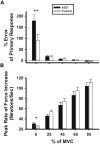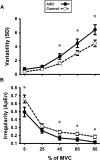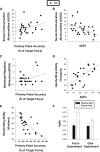Feedforward and feedback motor control abnormalities implicate cerebellar dysfunctions in autism spectrum disorder
- PMID: 25653359
- PMCID: PMC4315832
- DOI: 10.1523/JNEUROSCI.2731-14.2015
Feedforward and feedback motor control abnormalities implicate cerebellar dysfunctions in autism spectrum disorder
Abstract
Sensorimotor abnormalities are common in autism spectrum disorder (ASD) and among the earliest manifestations of the disorder. They have been studied far less than the social-communication and cognitive deficits that define ASD, but a mechanistic understanding of sensorimotor abnormalities in ASD may provide key insights into the neural underpinnings of the disorder. In this human study, we examined rapid, precision grip force contractions to determine whether feedforward mechanisms supporting initial motor output before sensory feedback can be processed are disrupted in ASD. Sustained force contractions also were examined to determine whether reactive adjustments to ongoing motor behavior based on visual feedback are altered. Sustained force was studied across multiple force levels and visual gains to assess motor and visuomotor mechanisms, respectively. Primary force contractions of individuals with ASD showed greater peak rate of force increases and large transient overshoots. Individuals with ASD also showed increased sustained force variability that scaled with force level and was more severe when visual gain was highly amplified or highly degraded. When sustaining a constant force level, their reactive adjustments were more periodic than controls, and they showed increased reliance on slower feedback mechanisms. Feedforward and feedback mechanism alterations each were associated with more severe social-communication impairments in ASD. These findings implicate anterior cerebellar circuits involved in feedforward motor control and posterior cerebellar circuits involved in transforming visual feedback into precise motor adjustments in ASD.
Keywords: autism spectrum disorder; cerebellum; precision grip; sensorimotor.
Copyright © 2015 the authors 0270-6474/15/352015-11$15.00/0.
Figures






Similar articles
-
Cortical and subcortical alterations associated with precision visuomotor behavior in individuals with autism spectrum disorder.J Neurophysiol. 2019 Oct 1;122(4):1330-1341. doi: 10.1152/jn.00286.2019. Epub 2019 Jul 17. J Neurophysiol. 2019. PMID: 31314644 Free PMC article.
-
Initial action output and feedback-guided motor behaviors in autism spectrum disorder.Mol Autism. 2021 Jul 10;12(1):52. doi: 10.1186/s13229-021-00452-8. Mol Autism. 2021. PMID: 34246292 Free PMC article.
-
Visual feedback and motor memory contributions to sustained motor control deficits in autism spectrum disorder across childhood and into adulthood.J Neurodev Disord. 2025 May 16;17(1):26. doi: 10.1186/s11689-025-09607-7. J Neurodev Disord. 2025. PMID: 40380091 Free PMC article.
-
Cerebro-cerebellar circuits in autism spectrum disorder.Front Neurosci. 2015 Nov 5;9:408. doi: 10.3389/fnins.2015.00408. eCollection 2015. Front Neurosci. 2015. PMID: 26594140 Free PMC article. Review.
-
The role of cerebellar circuitry alterations in the pathophysiology of autism spectrum disorders.Front Neurosci. 2015 Sep 1;9:296. doi: 10.3389/fnins.2015.00296. eCollection 2015. Front Neurosci. 2015. PMID: 26388713 Free PMC article. Review.
Cited by
-
Updating the research domain criteria: the utility of a motor dimension.Psychol Med. 2015 Oct;45(13):2685-9. doi: 10.1017/S0033291715000872. Epub 2015 May 25. Psychol Med. 2015. PMID: 26005109 Free PMC article.
-
The Naturalness of Biological Movement by Individuals with Autism Spectrum Conditions: Taking Neurotypical Individuals' Viewpoint.Open Access Maced J Med Sci. 2019 Aug 20;7(16):2574-2578. doi: 10.3889/oamjms.2019.392. eCollection 2019 Aug 30. Open Access Maced J Med Sci. 2019. PMID: 31777608 Free PMC article.
-
Applying Machine Learning to Kinematic and Eye Movement Features of a Movement Imitation Task to Predict Autism Diagnosis.Sci Rep. 2020 May 20;10(1):8346. doi: 10.1038/s41598-020-65384-4. Sci Rep. 2020. PMID: 32433501 Free PMC article.
-
A Cohesive Framework for Motor Stereotypy in Typical and Atypical Development: The Role of Sensorimotor Integration.Front Integr Neurosci. 2017 Aug 25;11:19. doi: 10.3389/fnint.2017.00019. eCollection 2017. Front Integr Neurosci. 2017. PMID: 28890690 Free PMC article.
-
Sensorimotor Behavior in Individuals With Autism Spectrum Disorder and Their Unaffected Biological Parents.Autism Res. 2025 Mar;18(3):498-514. doi: 10.1002/aur.70000. Epub 2025 Feb 17. Autism Res. 2025. PMID: 39957414
References
-
- American Psychiatric Association. Diagnostic and statistical manual of mental disorders. Ed 5. Arlington, VA: American Psychiatric Association; 2013.
Publication types
MeSH terms
Grants and funding
LinkOut - more resources
Full Text Sources
